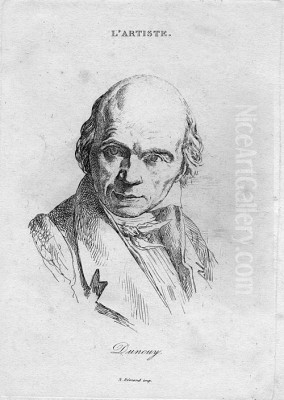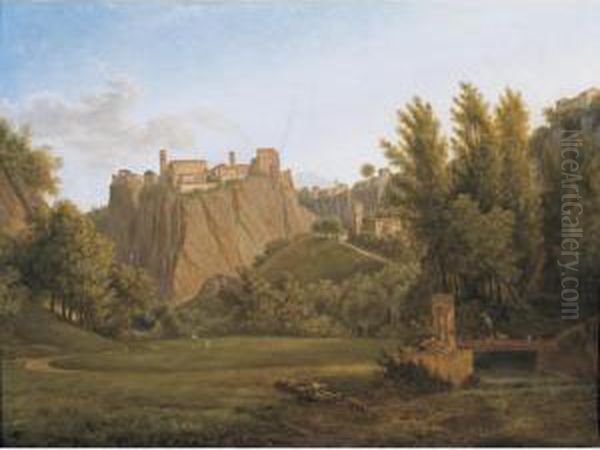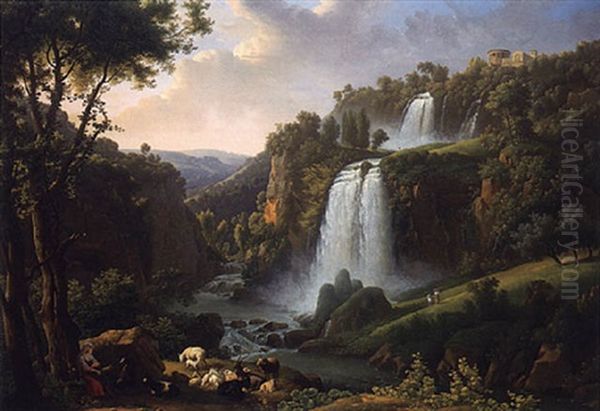
Alexandre Hyacinthe Dunouy (1757-1841) stands as a significant, though sometimes underappreciated, figure in the evolution of French landscape painting. Active during a tumultuous period that spanned the Ancien Régime, the French Revolution, the Napoleonic Empire, and the Bourbon Restoration, Dunouy's art navigated the shifting currents of Neoclassicism and burgeoning Romanticism. He was a painter who revered the classical tradition yet embraced the immediacy of nature, contributing to the vital transition towards a more naturalistic and emotionally resonant depiction of the landscape. His career, marked by prestigious Salon exhibitions, royal patronage, and a pioneering spirit in outdoor sketching, offers a fascinating window into the artistic concerns of his time.
Early Life and Artistic Foundations in Paris
Born in Paris in 1757, Alexandre Hyacinthe Dunouy emerged into a vibrant artistic milieu. The French capital was the undisputed center of European art, dominated by the Royal Academy of Painting and Sculpture, which dictated taste and provided the primary avenue for artistic training and recognition. Dunouy's formal artistic education was under the tutelage of Gabriel Briard (1725-1777). Briard, a respected history and landscape painter and a member of the Academy, would have instilled in his pupil the foundational principles of classical composition, drawing, and the hierarchy of genres, which placed history painting at its apex.
However, landscape painting was gaining increasing respect and popularity, moving beyond its traditional role as mere background for historical or mythological scenes. Artists like Claude-Joseph Vernet (1714-1789) had already achieved immense fame with their dramatic seascapes and topographical views, demonstrating the genre's potential for grandeur and emotional depth. It was within this evolving artistic landscape that Dunouy began to hone his skills, likely absorbing the prevailing taste for idealized, well-ordered scenes, yet perhaps already feeling the pull towards a more direct engagement with the natural world.
The Italian Sojourn: A Crucible of Inspiration

Like many ambitious artists of his era, Dunouy undertook the customary journey to Italy, a pilgrimage considered essential for any painter aspiring to master the classical tradition and witness firsthand the landscapes that had inspired generations of masters. He traveled extensively, visiting Rome and spending a significant period in Naples, where he resided until 1791. This Italian sojourn was profoundly formative. The Roman Campagna, with its ancient ruins, umbrella pines, and luminous atmosphere, had been immortalized by 17th-century masters such as Claude Lorrain (c. 1600-1682) and Nicolas Poussin (1594-1665).
Dunouy undoubtedly studied their works, absorbing their principles of harmonious composition, their skillful manipulation of light to create depth and mood, and their integration of classical or pastoral figures into idealized settings. The vibrant, sun-drenched landscapes of Naples and its surroundings, including the dramatic presence of Mount Vesuvius, offered a different, more untamed beauty. This direct exposure to the Italian light and topography, combined with the study of Italianate masters, deeply imbued Dunouy's artistic vision. He developed a particular fondness for depicting Italian scenery, a theme that would recur throughout his career and contribute significantly to his reputation. Other artists who found inspiration in Italy around this period, or whose Italianate works were influential, included Hubert Robert (1733-1808), known for his picturesque views of ruins, and later, Jean-Joseph-Xavier Bidauld (1758-1846), a contemporary who also specialized in meticulously detailed Italianate landscapes.
Return to Paris and Salon Recognition
Upon his return to France around 1791, Dunouy began to establish his career in Paris. The Paris Salon, the official art exhibition of the Académie des Beaux-Arts, was the primary venue for artists to display their work, gain critical attention, and attract patrons. Dunouy became a regular exhibitor at the Salon, participating consistently from 1791 through to 1833. His submissions often featured the Italian landscapes that had captivated him, rendered with a clarity and precision that appealed to contemporary tastes.
His Salon entries demonstrated a sophisticated understanding of perspective, a delicate handling of light, and an ability to create serene, often idyllic, views. These works found favor with the public and critics, gradually building his reputation as a skilled landscape painter. The Salon was a competitive arena, with artists like Pierre-Henri de Valenciennes (1750-1819), a key proponent of historical landscape and plein air sketching, and Jean-Victor Bertin (1767-1842), who would later teach Camille Corot, also vying for attention. Dunouy's success in this environment underscored his talent and his ability to connect with the prevailing aesthetic sensibilities while subtly pushing the boundaries of traditional landscape representation.
Innovating Landscape: The Embrace of Plein Air

One of Dunouy's most significant contributions was his early adoption and championing of plein air (outdoor) sketching. While the tradition of making studies from nature was not entirely new, the emphasis was typically on gathering information to be later synthesized into idealized compositions within the studio. Dunouy, alongside figures like Valenciennes, was among the pioneers who sought to capture the fleeting effects of light and atmosphere directly from nature, imbuing their work with a greater sense of immediacy and authenticity.
This practice represented a departure from the purely formal, often formulaic, compositions of stricter Neoclassicism. By working outdoors, Dunouy could observe the subtle nuances of color, the play of light and shadow, and the specific characteristics of a location with greater fidelity. This direct engagement with the natural world allowed him to infuse his landscapes with a freshness and vitality that broke through the constraints of purely studio-based work. While his finished Salon pieces would still often be carefully composed and polished, the underlying observations and the spirit of en plein air informed their execution, lending them a more convincing naturalism. This approach was a crucial step towards the later developments of the Barbizon School and Impressionism, where direct observation of nature would become paramount.
Royal Patronage and Esteemed Commissions
Dunouy's growing reputation attracted high-profile patrons. A significant moment in his career came in 1810 when he was appointed court painter to Joachim Murat (1767-1815), King of Naples and Napoleon Bonaparte's brother-in-law. This prestigious appointment not only provided financial stability but also affirmed his status as a leading landscape artist. Working for Murat, Dunouy would have been tasked with creating views of the Neapolitan kingdom, further cementing his association with Italian scenery.
Even before this royal appointment, Dunouy had connections with the Bonaparte family. He was commissioned by Joseph Bonaparte (1768-1844), Napoleon's elder brother and then King of Naples (before Murat, and later King of Spain), to paint views of his estate, the Château de Mortefontaine, near Paris. These commissions for aristocratic estates were common for landscape painters, allowing them to create idealized portrayals of pastoral life and the harmonious integration of man-made structures within a cultivated natural setting. These works often echoed the Claudian tradition of serene, well-ordered landscapes, populated with elegant figures.
Masterpieces and Signature Style: "Vesuvius" and "Mortefontaine"
Two works particularly exemplify Dunouy's artistic achievements and stylistic characteristics: "The Eruption of Vesuvius in 1813" and "View of the Park at Château de Mortefontaine."
"The Eruption of Vesuvius in 1813" captures the sublime and terrifying power of nature. Dunouy painted several versions of Vesuvius erupting, a popular subject that allowed artists to explore themes of awe, danger, and the dramatic interplay of light and shadow. In these works, he skillfully depicted the billowing smoke, the fiery lava, and the ash-laden sky, often contrasting the cataclysmic event with the relative calm of the surrounding landscape or the awestruck observers. The painting showcases his ability to handle complex atmospheric effects and to convey a sense of grandeur and drama, touching upon the nascent Romantic sensibility that valued emotional intensity and the power of the natural world. The meticulous detail in the rendering of the volcanic plumes and the dramatic lighting effects are characteristic of his careful observational skills, likely enhanced by his plein air studies.
"View of the Park at Château de Mortefontaine," created for Joseph Bonaparte, presents a contrasting vision of nature – one of serenity, order, and idyllic charm. This painting, or series of paintings, depicts the carefully manicured grounds of the estate, often featuring the château itself, tranquil bodies of water, and gracefully arranged trees. Figures, sometimes including members of the Bonaparte family, are often shown strolling or enjoying leisure activities, adding a narrative and personal dimension to the scene. The style here is more overtly Claudian, with a harmonious composition, soft, diffused light, and a sense of timeless peace. Dunouy’s skill in rendering foliage with precision, capturing the reflections in the water, and creating a balanced, picturesque view is evident. This work highlights his ability to cater to the tastes of his patrons for idealized representations of their domains, blending topographical accuracy with artistic embellishment.
Dunouy's overall style can be characterized by its clarity, precision, and delicate handling of light. His palette was often bright and his brushwork refined, allowing for a high degree of detail in foliage, architecture, and figures. While influenced by the classical tradition of idealized landscape, his commitment to outdoor observation lent his work a convincing naturalism. He masterfully balanced compositional harmony with an appreciation for the specific character of a place, whether it was the rugged terrain of Italy or the cultivated parks of France.
Influences, Contemporaries, and Artistic Dialogue
Dunouy's art was deeply rooted in the legacy of 17th-century classical landscape painters, particularly Claude Lorrain and Nicolas Poussin. From Claude, he inherited a sensitivity to atmospheric light, the creation of expansive, receding vistas, and the use of pastoral or mythological staffage to elevate the landscape. Poussin's influence can be seen in the careful structuring of his compositions and the intellectual rigor underlying the depiction of nature. He also would have been aware of the Dutch Italianate painters like Jan Both (c. 1610/18–1652) and Nicolaes Berchem (1620–1683), who also brought a Northern European sensibility to Italian scenes.
Among his French contemporaries, Dunouy's work can be compared and contrasted with several key figures. Jean-Joseph-Xavier Bidauld, his exact contemporary, also specialized in highly finished, detailed landscapes, often of Italian scenes, adhering closely to Neoclassical ideals. Pierre-Henri de Valenciennes was a more overt theorist and practitioner of plein air sketching for its own sake, advocating for the "historical landscape" as a genre worthy of the highest esteem. Jean-Victor Bertin, another prominent landscape artist, maintained a more traditional, classical style, and was an influential teacher.
Dunouy also engaged in collaborations. For instance, he is known to have worked with Auguste-Xavier Leprince (1799-1826), a younger artist known for his genre scenes and landscapes, who sometimes provided figures or other elements for the works of artists like Dunouy and André Giroux (1801-1879), another landscape painter who won the Prix de Rome. Such collaborations were not uncommon and highlight the interconnectedness of the Parisian art world. Other landscape painters active during parts of Dunouy's career included Lazare Bruandet (1755-1804), known for his forest scenes, and later, Achille-Etna Michallon (1796-1822), the first winner of the Prix de Rome for historical landscape, whose promising career was cut short.
Thematic Concerns and Broader Cultural Context
Dunouy's landscapes, while often focused on picturesque beauty, also reflected broader cultural and philosophical currents. His depiction of idealized estates like Mortefontaine spoke to a desire for order and harmony, a pastoral ideal that offered an escape from the turmoil of the revolutionary and Napoleonic eras. The choice to depict specific locations, whether Italian vistas or French châteaux, also catered to a growing interest in travel, topography, and the particular character of different regions.
Interestingly, some of Dunouy's works are noted to have included depictions of figures like the philosopher Jean-Jacques Rousseau (1712-1778). Rousseau's ideas about the importance of nature, the sublime, and the emotional response to the landscape had a profound impact on late 18th and early 19th-century thought, feeding into the Romantic movement. By incorporating such figures or allusions, Dunouy's work could engage with these contemporary intellectual trends, suggesting a landscape not just as a beautiful scene, but as a site for contemplation and emotional experience. His paintings of Vesuvius, for example, tap directly into the concept of the Sublime, as articulated by thinkers like Edmund Burke, where feelings of awe and terror are evoked by the overwhelming power of nature.
Later Career and Lasting Legacy
Alexandre Hyacinthe Dunouy continued to paint and exhibit into the 1830s, witnessing further shifts in artistic taste as Romanticism gained full force and the seeds of Realism were sown. While his style remained largely consistent with the principles he had developed earlier in his career, his dedication to landscape painting and his early adoption of plein air practices contributed to the gradual elevation of the genre.
His legacy lies in his role as a transitional figure. He successfully bridged the gap between the formal, idealized landscapes of the Neoclassical tradition and the more naturalistic, empirically observed landscapes that would come to dominate the 19th century. While perhaps not as revolutionary as some of his successors, Dunouy's meticulous craftsmanship, his sensitivity to light and atmosphere, and his commitment to capturing the essence of a place paved the way for later artists.
The generation of painters who formed the Barbizon School, such as Jean-Baptiste-Camille Corot (1796-1875), Théodore Rousseau (1812-1867), and Charles-François Daubigny (1817-1878), would take the practice of outdoor painting much further, making it central to their finished works. However, they built upon the foundations laid by artists like Dunouy, Valenciennes, and Bertin, who had already begun to explore the French countryside and the effects of natural light with a new intensity. Dunouy's dedication to both the Italianate tradition and the depiction of French scenery, along with his technical skill and Salon successes, ensured his place in the narrative of French landscape painting.
Conclusion: An Enduring Contribution
Alexandre Hyacinthe Dunouy died in 1841 in Jouy-en-Josas, near Versailles. Throughout his long and productive career, he remained a dedicated and skilled practitioner of landscape art. He adeptly navigated the artistic expectations of his era, from the demands of royal patrons to the competitive environment of the Paris Salon. His ability to synthesize the classical ideals of beauty and order with a more direct, observational approach to nature marked him as an important precursor to the more radical innovations in 19th-century landscape painting.
His works, characterized by their luminous clarity, meticulous detail, and often serene or dramatically evocative moods, continue to be appreciated for their aesthetic quality and their historical significance. Dunouy's paintings offer valuable insights into the art world of late 18th and early 19th-century France, reflecting a period of profound change both in society and in artistic expression. As a painter who embraced the lessons of the past while looking keenly at the world around him, Alexandre Hyacinthe Dunouy carved out a distinctive niche, leaving behind a body of work that testifies to the enduring allure of the landscape and the evolving ways in which artists have sought to capture its essence.